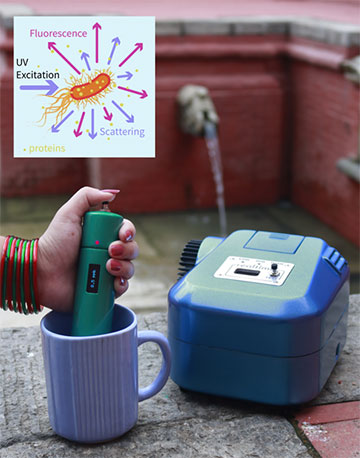
A highly sensitive lens-free fluorescence detection system (right) for finding deadly microorganisms in drinking water. The scientists are now converting the technology into a lensless dip-in handheld system (left) that could be useful for testing water quality in Kathmandu Valley, Nepal (background). [Image: Rijan Maharjan and Ashim Dhakal, Phutung Research Institute]
For centuries, residents of the Kathmandu Valley in Nepal have filled their drinking water vessels at communal stone spouts. With growing urbanization in the region, sewage and industrial runoff have infiltrated the shallow groundwater that the spout systems tap into, threatening to spread dangerous pathogens.
Now, researchers in Nepal, Brazil and the UK have developed a portable, lensless fluorescence-detection system that can reveal bacterial contamination in drinking water (Optica, doi: 10.1364/OPTICA.527289). The instrument can detect the presence of bacterial proteins down to a level of less than one part per billion, without the need for expensive ultraviolet-transparent lenses found in traditional fluorometers.
Detecting bad water
Instead of trying to count individual bacteria and viruses, the lens-free device designed by Ashim Dhakal and his team at the Phutung Research Institute, Nepal, measures the amount of fluorescence from tryptophan, a common amino acid found in E. coli and other germs.
As Dhakal explains, warm-blooded animals like humans cannot synthesize essential amino acids such as tryptophan, but E. coli bacteria produce and metabolize them. Not all strains of E. coli are harmful to people; however, the World Health Organization (WHO) recommends measuring E. coli’s presence in water supplies as a signal of potential fecal contamination.
Fortunately for scientists, tryptophan is one of three fluorescent amino acids (the other two are phenylalanine and tyrosine). The substance has a strong fluorescence maximum around 280 nm, and biochemicals derived from it have similar fluorescence peaks, Dhakal says.
“Our research, and the research from many others, has shown that the strength of the fluorescent signal is more important than counting the actual number of organisms in a given quantity of water,” Dhakal says. “However, the WHO’s standards are based on the traditional culturing methods―meaning that the E. coli bacteria needs to be specifically quantified.”
Lens-free beats lenses
The biggest challenge Dhakal and other Nepalese scientists face is the dearth of research funding in the small Himalayan country.
Dhakal and his colleagues, who included researchers from the universities of São Paulo, Brazil, and York, UK, performed extensive theoretical modeling to assure themselves that a lensless system would produce at least as good a signal as a typical lensed system. They found that lens-free devices actually produced higher signals, as long as the optical system’s numerical aperture was less than 0.83.
The lens-free experimental setup involved an illumination LED of 1 mm2 and a photodiode that was 2.4 mm2, placed at right angles around a cuvette containing an aqueous solution of tryptophan. The research team found that lensed systems lose up to 30% of the signal for a small misalignment in the optical path, whereas lensless systems lose only about 5%.
What the future holds
The most significant obstacle Dhakal and other Nepalese scientists face is the dearth of research funding in the small Himalayan country. Two years ago, Dhakal received an Optica Foundation Challenge grant to support his study into affordable, real-time water quality assessment. The team is developing a pocket-sized, field-tested and rugged version of the lens-free fluorometer that has “enhanced specificity for E. coli,” Dhakal says. His collaborators at the University of York are helping him obtain patents for the lens-free system, which he hopes will make it easier to gain funding for product development and production.
“We plan to produce the systems in Nepal―where we are based,” Dhakal says. “It will help minimize production and administrative costs and shorten the time needed for user-feedback and revision cycles. We will then move into other developing countries―where our system is really needed. We plan to devise a pricing scheme such that the potential customer base in the richer countries will support subsidizing the costs in the poorer countries.”
Dhakal also hopes the WHO and other health-related agencies revisit their clean-water standards to include spectral measurements rather than traditional culturing and counting of microorganisms. He says real-time fluorometric measurements are much more feasible than traditional methods in resource-limited settings.
